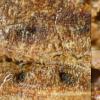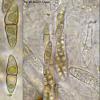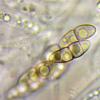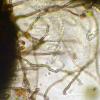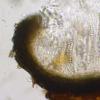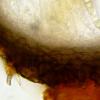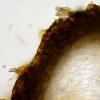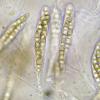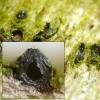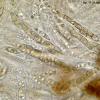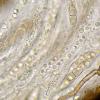
24-12-2025 17:08
Hulda Caroline HolteHello, I have found this propoloid ascomycete on

21-12-2025 09:32
Hello.A tiny ascomycete found embedded in wood in

21-12-2025 21:32
Pol DebaenstHello, Garden, Burgweg 19, Veurne, BelgiumOn 10/1

22-12-2025 23:38
Patrice TANCHAUDBonsoir, récolte sur un mur en pierre, apothéci

22-12-2025 00:47
Patrice TANCHAUDBonsoir, récolte à proximité du milieu dunaire

21-12-2025 21:40
Isabelle CharissouBonjour, j'aimerais connaitre les références de
Trematosphaeria pertusa
Björn Wergen,
10-03-2013 11:10
 Hi again,
Hi again,do you also think that this collection can be T. pertusa? I have found several articles and photos of this species but because of several contrarieties I do not really know how T. pertusa should look like. The spores of this collection are hyaline and 1septate in immature state, but they become 3 septate and pale greenish to greenbrown.
Macroscopically the perithecia are about 0,4-0,7 mm broad and sphaerical, with a pointed Ostiolus and covered with brown hairs (?).
Collected on attached twigs of Tilia cordata.
regards,
björn
Yannick Mourgues,
10-03-2013 11:39

Re : Trematosphaeria pertusa
Hi Björn .
I think it's not T. pertusa because in this specie (see Zhang & al 2008, Are Melanomma Pulvis-pyrius and Trematosphaeria pertusa congeneric ? - Fungal Diversity 33 : 47-60) spores are larger and longer, and dark brown :
"27.5-32.5x7,5-8,5 , fusiform with broadly to narrowly rounded end, dark brown, 1(-3) septate, (...), smooth to finely verruculose, without gel sheat"
Have your spores a gel sheat ?
May be you should make a vertical section of peridium to see cells structure.
Have you looked for in Massarina or Herpotrichia (subiculum ?) species ?
Yannick
I think it's not T. pertusa because in this specie (see Zhang & al 2008, Are Melanomma Pulvis-pyrius and Trematosphaeria pertusa congeneric ? - Fungal Diversity 33 : 47-60) spores are larger and longer, and dark brown :
"27.5-32.5x7,5-8,5 , fusiform with broadly to narrowly rounded end, dark brown, 1(-3) septate, (...), smooth to finely verruculose, without gel sheat"
Have your spores a gel sheat ?
May be you should make a vertical section of peridium to see cells structure.
Have you looked for in Massarina or Herpotrichia (subiculum ?) species ?
Yannick
Björn Wergen,
10-03-2013 11:56

Re : Trematosphaeria pertusa
Hi Yannick,
Herpotrichia is a good idea. But it is not H. herpotrichoides since I had this species already on Rubus sp. with different characters. I had also look for Massarina but I did not find any matching species.
I did not see a gel coat surrounding the spores.
regards,
björn
Herpotrichia is a good idea. But it is not H. herpotrichoides since I had this species already on Rubus sp. with different characters. I had also look for Massarina but I did not find any matching species.
I did not see a gel coat surrounding the spores.
regards,
björn
Björn Wergen,
10-03-2013 14:25
Ying Ying Zhang,
11-03-2013 03:13
Re : Trematosphaeria pertusa
??Hi Bjorn,
This species do not fit T. pertusa well. The ascospore of T. pertusa is pigmented. The ascomata do not covered with anything ("naked"). The ostiole (opening) is wide. But the shape of ascospores and asci of this collection are very similar with T. pertusa. I would like to take it as another species of Trematosphaeria s. s. As Trematosphaeria seems not rare in Europe, thus close relatives might also not rare.
Cheer up!
Ying
This species do not fit T. pertusa well. The ascospore of T. pertusa is pigmented. The ascomata do not covered with anything ("naked"). The ostiole (opening) is wide. But the shape of ascospores and asci of this collection are very similar with T. pertusa. I would like to take it as another species of Trematosphaeria s. s. As Trematosphaeria seems not rare in Europe, thus close relatives might also not rare.
Cheer up!
Ying
Björn Wergen,
11-03-2013 21:40

Re : Trematosphaeria pertusa
Hi Ying,
thanks for the respond. I have recently found this species again, on Ulmus.
regards,
björn
thanks for the respond. I have recently found this species again, on Ulmus.
regards,
björn
Björn Wergen,
08-05-2013 16:44

Re : Trematosphaeria pertusa
I have found it again, this time on decorticated Acer stems (~5cm).
The spores are a bit smaller than in the other 2 collections, and I haven't seen any spores with more than 1 septa.
As already seen in the other photos, this collection also had a hyphal layer on the small, black perithecia (diam. ~ 0,6mm, beaked).
I have called it "Trematosphaeria lignicola" for now.
I will add it to my special herbarium for further studies.
regards,
björn
The spores are a bit smaller than in the other 2 collections, and I haven't seen any spores with more than 1 septa.
As already seen in the other photos, this collection also had a hyphal layer on the small, black perithecia (diam. ~ 0,6mm, beaked).
I have called it "Trematosphaeria lignicola" for now.
I will add it to my special herbarium for further studies.
regards,
björn
